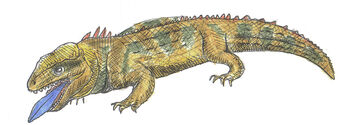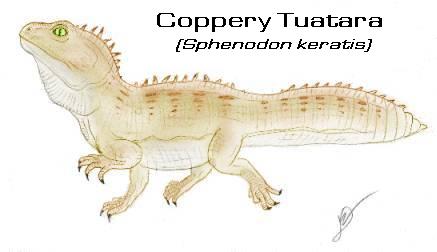Sphenodontida is an ancient group of lizard-like reptiles that enjoyed great success during the Mesozoic. The sphenodonts' kin, rhynchocephalians, or "beak heads", spread across the globe, both in Laurasia and Gondwana. Fossil rhynchocephalians are poorly-studied, but it seems they radiated into a number of forms, including the lizard-like types that are now their only legacy.
Order sphenodontida, the tuataras, are all that remains of the once fecund rhynchocephalian tree. Occurring in but one genus, Sphenodon (Spec's p-Shenodon), tuataras resemble lizards in their outward form, but their inner anatomy is quite strange. Sphenodonts lack the kinetic, flexible jaws of lizards, building their skulls, instead, out of resilient plates of bone. Their teeth are not rooted in the jaw as in lizards and mammals but actually fused into the mandible. Some features of the tuataras' skulls resemble those of crocodiles, and their hearts are the most primitive known in reptiles. Tuataras have a very slow metabolism and often live for over a century.
Today, sphenodonts are restricted to parts of Australia, Tasmania, Aotearoa, and the surrounding islands.
Coppery Tuatara (Sphenodon keratis)[]
The coppery tuatara is one of the few sphenodonts that have survived to the present, inhabiting New Zealand and some parts of Australia. This species can grow to be half a meter long and lives up to 100 years. The copper tuatara uses its long spiked front limbs to dig up grubs and its large, plump tail is used to store water during the dry season.

Fung-toungue, p-Sphenodon luminosa (Aotearoa---see Waitomo cave)
BOROSPHENDODONTIDAE: (Blueys, Larrys, Crackerjacks and Beakuanas)[]
This group is most closely related to the sphenodontians of Aoteoroa, but consists of numerous species that are larger, and have significant physiological, dental, and metabolic differences to any other sphenodonts known.
Crackerjack (Borosphenodon horribilis)[]

Scutes of the crackerjack.
The most famously known member of the group is the Crackerjack (Borosphenodon horribilis). This sphenodont is found throughout Australia and Papua, and weighs a whopping 1 tonne in the largest specimens, and measure from three to four meters in length. They mainly feed on carcasses left behind by large predaceous dinosaurs, having stout, immensely powerful jaws, filled with robust, semi-conical teeth.
They possess strong external dermal armour, consisting of large scutes, and a layer of cutaneous armour several inches thick, sitting on a layer of subcutaneous fat. This leathery armour makes them nearly impenetrable. They have regularly seen trailing groups of rhynchoraptors, and can reduce euclasaur femurs and hip bones to nothing in remarkably little time. Thy rest mainly in mud and water, adding to their putrid stink, and any social tussles are handled by bunting each other with their cranial and nasal horns.
Larrys and Blueys (Choosphenus sp. and Tiquillosphenus sp.)[]

Blue-tongued tuatara (Tiquillosphenus sp)
Larrys (Choosphenus sp) and Blueys (Tiquillosphenus sp), are much more conservative members of Ozpec's herpetofauna. They take the roles that, in our timeline, went to large skinks like Tiquilla. They feed on almost anything, invertebrates, small vertebrates, carrion, fruit, flowers, tubers, and even eggs. They, for the most part, resemble the tuataras of the genus Sphenodon, but are usually patterned in shades of grey or brown, with darker stripes or blotches. Blueys, like the eastern bluey (Tiquillosphenus ledii) have bright blue tongues used in defensive bluff displays. They mainly attain a length of around 50 to 70 centimeters, but the northern giant larry (Choosphenus giganteus) regularly attains a length of 1 to 2 meters. The Sdelaide pygmy bluey (Tiquillosphenus nanus) is a plain brown species that commonly makes it's home in ant colonies, being relatively tiny, at only 15 centimeeres in length. Reports of such a creature were disregarded as misidentifications of Agamids or skinks, until a specimen was exhumed from a small snake, subsequent searches or nearby areas allayed any misconception.
Beakuanas[]
A recently discovered group of sphenodonts that inhabit Aoteoroa, these sphenodonts are only native to that area. Possibly as a refuge from the rest of the world. As of now, only 3 species are known to inhabit the island. All three known species are herbivores
Hawkin's beakuana (Hawkinsphenodon giganteus)[]
A denizen from New Caledonia, this beakguana is notable for the presence of a small keratinous horn on the snout and for the lack of a beak in the lower jaw. Indeed, Demirostrum is the most basal living beakguana genus, reduced to three living modern species on Pacific islands. A medium sized beakguana, with a length of one meter, this chubby looking animal avoids competition with the native terrestrial treeguana rath by being more folivorous, and indeed it has an unusually less extreme diet for a beakguana, not targeting hard or poisonous plants any more than more edible ones. Its only natural predator is dudus and predatory birds, and thus they have hardly any osteoderms and only lay four eggs at a time.
Edaph-beakuana (Neoedaphosaurus knighti)[]
Occurring in the same area as greater beakguanas, this one is smaller and has a bright yellow colouration. To avoid competition with their bigger cousins they are much pickier eaters, feeding exclusively on the most toxic or fibrous plants, that few other vertebrates can eat. In order to cope with this extreme die,t they spend hours immobile, trying to digest the meal. This leaves them very vulnerable to predators, and because their spike- like osteoderms aren't enough defense they developed n unique way to scare off predators: as their name implies, they developed a dorsal fin, making them slightly resemble the ancient pelycosaurs.
Said fin isn't supported by dorsal bones, but by ossified cartilage ridges, and is usually retracted on the back. When threatened, it rises, and because it contains chromatophores akin to those of chameleons it easily develops a large, eye like spot, which confuses the predators. The sail also has a thermoregulating function, as the pelycosaur sails likely had. A similar species is the greater beakguana (Neoedaphosaurus giganteus), which rivals the greater beakguana in weight, though not in length.
Greater beakuana (Rynchosphenodon bifurcomandibularis)[]
The biggest living beakguana is an animal that rivals with the terrestrial island iguana from HE's Galapagos in size. Grey in colour, it occurs in the Australian outback, having crepuscular tendencies. It uses its hooked jaws to tear off tough plant matter, which is later smashed by the gastroliths in its gut and digested by a diverse stomach flora, as in all beakguanas. Its large size and strength meas few cedunosaurs and wolfcrocs dare to attack it, as its jaws can break a leg of one of those animals, though ful- grown carnocursorids and rhynchoraptors might pose a threat, thus they have osteoderms on their skin, though they serve more to help it in camouflage than to actually be used as armour, so loose and small as they are. They breed in the rain seasons, burying their eggs on the sand; newborns are fully carnivorous, but they slowly become herbivores as they grow, eating the adult's feces to obtain the gut flora.
,=p-S. keratis (Coppery tuatara)
=Sphenodontida=p-Sphenodon=|
`=p-S. luminosa ( Fung-tongue)






